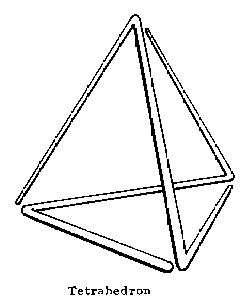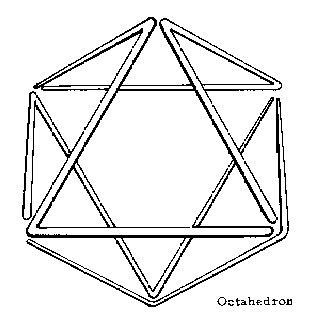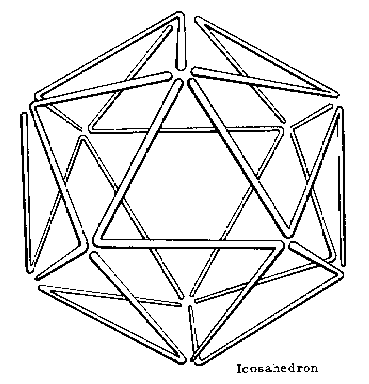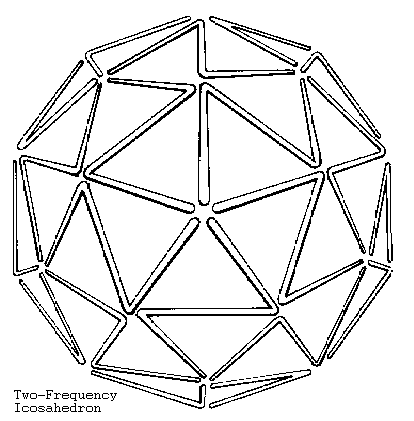
| Previous Section | Contents | Next Section |
What I wish to communicate to you now is all-and-only that which I consider germane to your questioning of how tensegrity structuring can be comprehensively comprehended and formally calculated as in the following illustrations on how tensegrity-geodesic structure function on a microcosmic level.
[Editor's note: A slightly different version of the following seventeen paragraphs appears on pp. 174-182 of Cosmography.]
The balloon is a net in which the holes are so small that the molecules of gas inside the balloon are larger than the holes and wherefore the molecules cannot get out. The next thing that we discover is the pressure of the gases explained by their kinetics. That is, the molecules are in motion: they are not rigid. There is nothing static at all pushing against the net. The gas molecules are hitting it like projectiles. All of the molecules of gas were pressure loaded into the system and are tying to get out of the system: this is what gives the basketball its firmness. If we pump in more molecules they are not only more crowded but more accelerated. This produces heat and ever greater pressure.
The middle of the chord of an arc is always nearer to the center of the sphere than the ends of the chord. Chord ends are always pushing the net outwardly from the system's spherical center. The gas molecules are stretching the net outwardly. All outwardly thrusting gas molecules have an-equal-and-opposite thrusting reaction molecule partner. In the tensegrity sphere model each of the wooden sticks or struts represents a pair of action-and-reaction forces of the gas molecules outward caroming blows is a total spherical enlargement which stretches the skin. The skin (network stringing) acts to resist the outward motion (stretch), The skin is finite and closes back upon itself in all circumferential directions. The net represents a tensional force with all its force arrows bound inwardly, balancing all the outward bound molecules, hitting the net and caroming around, with every molecule action having its equal and oppositely accelerative gas molecule reaction mate. The two paired action and reaction gas molecules produce glancing-blow, chordal pair, outward forces of the tensegrity sphere.
The molecules do not huddle together at the spherical center and then simultaneously explode outward to hit the balloon skin in one omnidirectionally outbound wave. Instead the paired oppositely accelerated gas molecules carom around in the largest, most comfortable circles (the great circles). All great circles cross other great circles twice in each circuit. When a third great circle crosses two others it inherently produces six vertex crossings and eight asymmetric spherical triangles. This is the spherical octahedron. The opposite direction reaction molecule makes its spherical octahedron. The two spherical octahedra's 12 vertices produce the icosahedron's twelve vertices. With millions of the fast formation of the asymmetric icosahedral patterning the plus-minus averaging produces the regular icosahedral sphere.
Not only are there critical proximities that show up physically, but there are critical proximities tensionally and critical proximities compressionally -- that is, there are repellings.
What makes the net take the shape that it does is simply the molecules that happen to hit it at any one moment. The molecules that are not hitting at the moment considered have nothing to do with the balloon's or the basketball's shape. There is the certainty that other molecules might hit the network at other moments but that is not what we are concerned with. The shape it has at any one moment is only by virtue of the ones that are hitting it at that moment.
The molecules near the surface of the net are coursing in chordally ricocheting great-circle patterns around the net's inner surface. Because every action has its reaction, it would be possible to pair all the molecules so that they would behave as, for instance, two swimmers do who dive into a swimming tank from opposite ends, meet in the middle, and then, employing each other's inertia, bend tight their knees and bodies and shove off from each other's feet in opposite directions. This produces and acceleration effectiveness equal to what the swimmers experience when shoving off from the tank's "solid" wall.
The pattern indicates that we could have each and all of the paired molecules bounce off their partners and dart away in opposite directions, with each hitting the balloon net and pushing it outwardly as they each angled off from glancing blows to travel in new directions, but always toward the net at another point where at critical repelling proximities, they pair off nonsimultaneously at high frequency of re-repellment shove-offs to ricochet off the net at such a high frequency of events as to keep the net stretched outwardly in all directions. This represents what the molecules of balloon or basketball or football or tennis ball or ping pong ball-confined gases are doing. With discontinuous compression and continuous tension, we make geodesic structures function in the same way.
There is always water intervening between the surface or the feet of the swimmers shoving off from one another. This water produces internal between the swimmers a critical proximity of their energy interpatterning.
| Figure 19 | Function of a Balloon as a Porous Network |
| ( Fig. 761.02 from Synergetics) |
The spaces between the energy-action-net components are smaller than are the internally captivated and mutually interrepelled gas molecules; wherefore the gas molecules, which are complex low-frequency energy events, interfere with the higher-frequency, omnienclosing net-webbing energy events. The pattern is similar to that of fish crowded in a spherical net and therefore running tangentially outward into the net in approximately all directions. Fish caught in nets produce an enclosure-frustrated, would-be escape pattern. In the tensegrities, you have gravity or electromagnetism producing the ultimate tension forces, but you don't have any strings or ultimately smallest solid threads. The more we think about it and the more we experiment, the less reliable becomes our academic concept "solid." The balloon is indeed not only full of holes, but it is in fact utterly discontinuous. It is an energy network and not a bag. In fact, it is a spherical neighborhood of critically proximate interattraction of ultra-high-frequency energy events.
In a gas balloon. we do not have a continuous membrane of film.
There is no such thing as a continuous "solid" skin or a "solid" or a "con-
tinuous" anything in Universe. What we do have is a network pattern, a
network of energy actions interspersed with vast spaces or lack of energy
events. The mass-interattracted atomic components not only are not touching
each other, but they are as remote from one another as are Sun and its planets
People think spontaneously of a basketball as a continuous skin or
solidly impervious unitary and spherically enclosed membrane holding the gas. They say that because the gas cannot get out and because it is under pres- sure, the pressure makes the balloon spheroidal. This means that the gas is pushing the skin outwardly in all directions. People think of a solid mass of air jammed into a pneumatic bag. But if we look at this skin with a micro-
scope, we find that.it is not a continuous film at all: it is full of holes. It is made up of molecules that are fairly remote from one another. It is in reality a great energy aggregate of Milky Way-like atomic constellations cohering only gravitationally to act as the invisible, tensional integrities of the energetic, high-frequency event "fibers" with which the webbing of the pneumatic balloon's net is woven.
We now comprehend that geodesic tensegrity structuring provides
the first true and visualizable model of pneumatic structures in which the rela-
tive thickness of the enclosing films, in proportion to diameter, rapidly de-
creases with the increasing size of the balloons or spheric networks.
In the case of geodesic tensegrity structures, no overcrowding of
interior gas molecules, imprisoned within a submolecular mesh net, is neces-
sary to thrust the net's structure outward from its spherical geometric center,
because the compressional struts, locally islanded. as outward-thrusting struts
at both their ends, push the spherical net outwardly at every vertexial advan-
tage of network convergence. Geodesic tensegrities are the "hollowed-out"
balloons discarding their redundantly "solid" air core.
The larger the sphere the greater the number of molecules, the lower the pressure and the more the surface on which to distribute the "loadings" or pressured impinging upon the pneumatic system. Doubling the size of the pneumatic or tensegrity sphere reduces the surface enclosure stressing to one quarter the former local slow stressing occasioned by an external force impingement of a given magnitude.
Geodesic tensegrities are true pneumatic structures in purest de-
sign frequency principle. They obviate the randomness and redundance char-
acterizing the work of designers dealing only with pneumatics who happen to
be successful in blowing air into a bladder while being utterly dependent upon
the subvisible behaviors of chemical phenomena. Geodesic tensegrity engi-
neering enables discrete separation of all the structural events into two diamet-
rically opposed magnitude classes: all the outward-bound phenomena which
are too large to pass through all the interstices of all the inward-bound events
in the too-small class. This is the same kind of redundancy that occurs in rein-
forced concrete which, if drilled out wherever redundant components exist,
would disclose an orderly four-prime-magnitude complex octahedron-
tetrahedron truss network, disencumbered of more than 50 percent of its
weight.
| Figure 20 | Chordal Ricochet Pattern in Stretch Action of a Balloon Net |
| ( Fig. 762.01 from Synergetics; Fig. 6.45 from Cosmography with some punctuation changes) |
The geodesic tensegrity is a balloon out of which have been removed all the molecules of gas not at the moment hitting the skin and in which those
specific molecules of gas that happen to be impinging from within against the skin at any one moment (thus pushing it outwardly) are replaced by the islanded geodesic struts, and all other redundant molecules are discarded. It is possible to sew pockets on the inside surface of a balloon skin corresponding in pattern to the islanded tensegrity geodesic strut-end positions and to insert into those pockets stiff battens that cause the otherwise limp balloon bag to take spherical shape, as it would if filled with a pressured-in gas.
If we employ hydraulic pressure within the local islands of com- pression for dimensional stability, and if we employ gas molecules between the liquid molecules for local shock-load compressibility (ergo, flexibility), we will find that our geodesic tensegrity structures will in every way have taken advantage of the same structural-strategy principles employed by nature in all her sizes of biological formulations.
We then discover that all geometrical structural systems can be encompassingly realized by only the isolated omni-islanded discontinuous compression (repulsive) force components omni-integrated by the always closed back into itself, continuous tensional network of interattracting. This is to say that for every geometrical structural system, simple or complex, there is always a tensegrity structure.
| Figure 21 | Basic Tensegrity Structures |
| (Similar to Fig. 724.10 from Synergetics) | |
| Figure 22 | Dimpling Effect |
| (Similar to Fig. 618.01 from Synergetics) | |
| Figure 23 | Behavior of Six-Strut Tensegrity Icosahedron and Six-Strut Tensegrity Octahedron |
| ( Fig. 724.30 (with a modified title) from Synergetics) | |
| Figure 24 | Transformation of Six-Strut Tensegrity Structures |
| (Similar to Fig. 725.02 from Synergetics) | |
| Figure 25 | Tetrahedron as Vectorial Model of Quantum |
| (Similar to Fig. 620.06 from Synergetics) |
One quantum of structuring energy is always six concurrently push-pull vectors. The six push-pull quanta cope exactly with the twelve inherent degrees of freedom of independent systems in Universe. Precession is the effect of a body in motion on another body in motion, ergo, is the effect of kinetic force on another kinetic force. Since vectors represent forces operating in specific direction, precession is also the effect of a vector on another vector, and the effect never results in a 180° resultant or reaction. The angular shunting of precession is usually at 60° but is sometimes a 90° veering. The effect of the in-motion Sun's gravitational null on the in-motion Earth is the veer the Earth with a gravitationally pulled force into a 90° change of direction making it orbit around the Sun.
Two vectors convergent have no inherent insideness or outsideness, no concavity or convexity: no volume enclosing.
Enclosing one unit of volume with one structural quantum (six push-pull vectors), the tetrahedron with six push-pull vectors, three convergent at each vertex, is the minimum structural system in Universe.
The octahedron has four vectors (concavely inside and convexly outside) convergent at each vertex. The octahedron has four times the volume of the tetrahedron accomplished with only two structural quanta -- two volumes per quantum.
The icosahedron has five vectors convexly and concavely convergent at each vertex and has 18.51 times the volume of the tetrahedron while employing only five structural quanta -- 3.7 volumes per quantum.
It is impossible to have a system with six vectors convergent at each vertex of an omni-equi-angled triangulated system because the six 60-degree angles would amount to 360 degrees and constitute a plane extending laterally outward to infinity never to return upon itself to enclose and isolate a system from the macro- and micro-cosms.
There are, therefore, only three primitive structural systems in Universe: the tetrahedron, octahedron, and icosahedron. Since the tetrahedron provides only one unit of volume per structural quantum and the octahedron two units of volume per structural quantum and the icosahedron 3.7 per structural quantum, the icosahedron is the most volume per energy output system in Universe.
[Editor's note: A slightly different version of the following paragraph appears on p. 174 of Cosmography.]
When NASA was making its first rocketry experiments and the problem of atmospheric re-entry heats was being dealt with, two General Dynamics scientists were making experiments with the light, high-strength metal titanium. They made two thin-wall hemispheres of titanium sheet. One of the hemispheres had a 36 inch inside diameter and the other 34 inches outside diameter. They centered the 34 inch dome inside the 36 inch dome with a one-inch space between them. With a titanium base ring one-inch high with an inside diameter of 34 inches and outside diameter of 36 inches, they welded the ring in place to both the outside and inside domes. They then vacuum pumped out the air from between the two domes. The atmospheric pressure pushed the inside dome skin outwardly but the atmospheric pressure on the outside of the outside dome dimpled the outside dome skin inwardly in the exact hexagon-pentagon triangle pattern of the tensegrity - geodesic icosahedron's 4-frequency hexagons. This was a least effort of nature event and proved that nature was employing the same mathematical geometrical logic we have been developing here which shows that the icosahedron provides the cosmically most structurally enclosed volume per quanta of structural energy employed.
Summarizing:
One quantum of energy is the amount necessary to structure the minimum structural system in Universe the tetrahedron's positive and negative congruent vectors.
One quantum (six push-pull vectors) structurally encloses one tetrahedron's unit of volume (1 Q = 1 vol or a 1/1 of structural "advantage.")

Two quanta enclose four units of volume (2 Q = 4 vols or a 2/1 of structural advantage.)

Five quanta enclose approximately 20 units of volume (5 Q = 20 vols or 4/1). Exactly, it is (5 Q = 18.51 units of volume or 3.7 of structural advantage).


Triangular Spiral Events Form Polyhedra
[Editor's note: The previous four in-text figures are taken from Fig. 613.01 of Synergetics.]
Six push-pull vectors equal 1 unit of structural-system-forming capability equals one quantum. The icosahedronal system encloses the most volume with the least structural energy quanta of the three only primitive structural systems of universe. The greater the frequency of modular subdivision of the icosahedron the greater the volume and the more spherical the total conformation.
| Table 2 | Tetrahedral Mensuration Applied to Spheres |
| ( Table 224.70B from Synergetics) | |
| Figure 26 | Six-Frequency Tensegrity Icosahedron |
| (Fig. 6.42 from Cosmography) |
As defined by the Greeks, a sphere is a surface equidistant in all directions from a point. A Greek sphere could therefore have no holes in it. The holes' rims would involve shorter radii. Therefore, as defined by the Greeks, the sphere consisted of an absolutely solid continuum which, having no interstices or holes or passageways, could not allow energy to enter or exit, ergo would defy the "great" second law of themodynamics -- entropy -- and therefore would become the first local perpetually regenerating system in Universe. Ergo, the remainder of the complex, every-where and -when, intertransforming nonsimultaneous regenerative events or Universe would be excessive and redundant. Since nature always accomplished her events in the most economical way she would use the solid sphere but no solids are in experiential evidence.
Since physics has discovered no absolutely solid continua, we find it necessary to redefine the spheric experience. Our definition of the spheric experience is "an aggregate of events approximately equidistant in approximately all directions from one small, central, minimum-system locus. Recognizing that "approximately all directions" involves a vast number of measurements requiring a vast amount of time, within an ever transforming Universe which accounts for that only "approximately" equidistance, all of which means that the spheric experience is an aggregate of mini-system "points," approximately equidistant in almost all directions from one central mini-system "point." Each of the spheric aggregate of points (systems) will have its nearest neighboring points (systems). Most economically interconnecting those points with their nearest neighbors involves omni-intertriangling the whole spheric array which means producing high frequency geodesic spheres in whose surface aggregation of points it will be found that the sums of the angles around all the surface points will always be a number which is 720 degrees less than the total number of spheric points multiplied by 360 degrees.
Seven-hundred-and-twenty degrees is the sum of the angles around all the vertexes of a tetrahedron. The sum of the angles around the vertexes of all systems, symmetrical or asymmetrical, be they crocodiles, ostriches or spherics, are always the remainder of subtracting one tetrahedron's 720 degrees from the number which is the product of multiplying all the vertices of the system by 360 degrees.
Universe is the sum of all positive and negative intercomplementations and to realize a system -- for instance a thought -- means tuning in the thought and leaving all the rest of the Universe untuned. This is done by subtracting or withdrawing one tetrahedron.
System + tetrahedron = Universe
or more correctly
System + macrotetra + microtetra = Universe.
[Editor's note: From reading the text in Synergetics, §§ 224.20, I think the following lines got left out here:
S + 720° = 360° Xn
Where:
S = the sum of all the angles around the vertexes (crossings)]
Xn = the total number of vertexes (crossings)
| Table 3 | Angular Topology Independent of Size |
| ( Table 224.20 from Synergetics) | |
| Table 4 | Tetrahedral Mensuration Applied to Well-Known Polyhedra |
| ( Table 224.70A from Synergetics) |
We next discover that the higher the frequency of spherical tensegrity structure, the shorter are the islanded compressional chords which indicate that at very high frequency the chordal struts contract to become islanded spheres -- spheres of compression. Any axis of a sphere is a neutral axis and the high frequency asymmetric polyhedra (the so-called spheres) contain the most volume with the least surface. The "sphere" is the unattainable limit of line contraction.
We then discover that what has long disturbed physicists, i.e. the seemingly contradictory coexistence of particle discontinuity and wave continuity. Particle discontinuity is islanded compression of Universe and wave continuity is tensional, gravitational integrity of Universe. Discontinuous compression; continuous tension. Tensegrity. In tensegrity, all the system's tension vectors are inherently wavilinear and are vibratable and always distribute their closed system tension-imposed stressing absolutely evenly (as the pneumatic tires distribute their internal pressures evenly to all their tensionally enclosing high-tension resistant tire casings (see illustrations, pages 58 and 61).
Each tensegrity system can be overall, evenly tunably tightened or loosened by the internal (microcosmic) and external (macrocosmic) forces internally and externally affecting the system by its cosmic environment neighboring system.
Particles are tetrahedronal islands of compression.
Closed back on itself continuous tension is wave; spherical islands of compression are icosahedronal aggregates of tetrahedronal particles. Only in an ultra high-frequency polyvertexial system (the quasi sphere) is every axis a neutral axis. "Spheres" are the limit reaction conformation of all omni-interrepulsive forces. "Spheres" may be implosive or explosive; may be energy importers or exporters; planets or stars; atomic nuclei or icosahedronal aggregates of tetrahedronal photons.
All structural systems can be demonstrated as tensegrity models. The relative lengths of either the interpulsing or interattracting vectoral components of any and all structural systems can be determined swiftly by spherical trigonometry and slowly by XYZ coordinate calculus. The tension and compression components are all chords of central angles of the convergent-divergent spherical configurations of one or more of the seven sets of unique great circle symmetries corresponding indirectly to all seven of the crystallographic symmetries.
See Synergetics for all such data.
The spherical trigonometry is simple and with the trigonometric pocket computers makes possible obtaining the chord data in minutes for any structural system. If you want to use science's XYZ coordinate system, you'll have to use science's calculus which will take you much longer.
| Previous Section | Contents | Next Section |